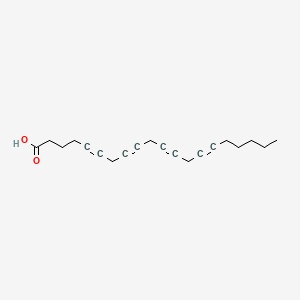| Jozefowski S et al. |
Leukotrienes modulate cytokine release from dendritic cells. |
2005 |
Immunology |
pmid:16313356
|
| Downie MM et al. |
Peroxisome proliferator-activated receptor and farnesoid X receptor ligands differentially regulate sebaceous differentiation in human sebaceous gland organ cultures in vitro. |
2004 |
Br. J. Dermatol. |
pmid:15491415
|
| Sokolowski BH et al. |
Identification and localization of an arachidonic acid-sensitive potassium channel in the cochlea. |
2004 |
J. Neurosci. |
pmid:15254081
|
| Zuo L et al. |
Lipoxygenase-dependent superoxide release in skeletal muscle. |
2004 |
J. Appl. Physiol. |
pmid:15107407
|
| Bandell M et al. |
Noxious cold ion channel TRPA1 is activated by pungent compounds and bradykinin. |
2004 |
Neuron |
pmid:15046718
|
| Chen N et al. |
Inhibition by arachidonic acid and other fatty acids of dopamine uptake at the human dopamine transporter. |
2003 |
Eur. J. Pharmacol. |
pmid:14575792
|
| Carr MJ et al. |
A role for TRPV1 in bradykinin-induced excitation of vagal airway afferent nerve terminals. |
2003 |
J. Pharmacol. Exp. Ther. |
pmid:12604706
|
| Jelson GS et al. |
Modulation of guinea pig intrinsic cardiac neurons by prostaglandins. |
2003 |
Am. J. Physiol. Regul. Integr. Comp. Physiol. |
pmid:12791585
|
| Bell MV et al. |
Pyloric ceca are significant sites of newly synthesized 22:6n-3 in rainbow trout (Oncorhynchus mykiss). |
2003 |
Lipids |
pmid:12669818
|
| Sergeeva M et al. |
Arachidonic acid in astrocytes blocks Ca(2+) oscillations by inhibiting store-operated Ca(2+) entry, and causes delayed Ca(2+) influx. |
2003 |
Cell Calcium |
pmid:12618149
|
| Moneer Z et al. |
Nitric oxide co-ordinates the activities of the capacitative and non-capacitative Ca2+-entry pathways regulated by vasopressin. |
2003 |
Biochem. J. |
pmid:12459038
|
| Oltman CL et al. |
Reactive oxygen species mediate arachidonic acid-induced dilation in porcine coronary microvessels. |
2003 |
Am. J. Physiol. Heart Circ. Physiol. |
pmid:12869369
|
| Carattino MD et al. |
Arachidonic acid regulates surface expression of epithelial sodium channels. |
2003 |
J. Biol. Chem. |
pmid:12837767
|
| Bryja V et al. |
Lipoxygenase inhibitors enhance tumor suppressive effects of jun proteins on v-myb-transformed monoblasts BM2. |
2003 |
Prostaglandins Other Lipid Mediat. |
pmid:14674625
|
| Alaoui-El-Azher M et al. |
Arachidonic acid differentially affects basal and lipopolysaccharide-induced sPLA(2)-IIA expression in alveolar macrophages through NF-kappaB and PPAR-gamma-dependent pathways. |
2002 |
Mol. Pharmacol. |
pmid:11901217
|
| Ramakers GM and Storm JF |
A postsynaptic transient K(+) current modulated by arachidonic acid regulates synaptic integration and threshold for LTP induction in hippocampal pyramidal cells. |
2002 |
Proc. Natl. Acad. Sci. U.S.A. |
pmid:12114547
|
| Moody JS and Marnett LJ |
Kinetics of inhibition of leukocyte 12-lipoxygenase by the isoform-specific inhibitor 4-(2-oxapentadeca-4-yne)phenylpropanoic acid. |
2002 |
Biochemistry |
pmid:12162745
|
| Signorello MG et al. |
Effect of homocysteine on arachidonic acid release in human platelets. |
2002 |
Eur. J. Clin. Invest. |
pmid:11952814
|
| Guidarelli A and Cantoni O |
Pivotal role of superoxides generated in the mitochondrial respiratory chain in peroxynitrite-dependent activation of phospholipase A2. |
2002 |
Biochem. J. |
pmid:11994047
|
| Weiss DJ and Evanson OA |
Evaluation of lipopolysaccharide-induced activation of equine neutrophils. |
2002 |
Am. J. Vet. Res. |
pmid:12061525
|
